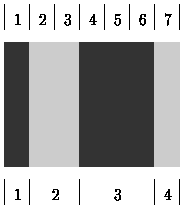IOI '95 - Eindhoven, Netherlands
Bar Codes
A bar-code symbol consists of alternating dark and light bars, starting with a dark bar on the left. Each bar is a number of units wide. Figure 1 shows a bar-code symbol consisting of 4 bars that extend over 1 + 2 + 3 + 1 = 7 units.

Figure 1: Four fences and some of their letter strings (joints not to scale)
In general, the bar code BC(n, k, m) is the set of all symbols with k bars that together extend over exactly n units, each bar being at most m units wide. For instance, the symbol in Figure 1 belongs to BC(7, 4, 3) but not to BC(7, 4, 2).
0: 1000100 | 8: 1100100 1: 1000110 | 9: 1100110 2: 1001000 | 10: 1101000 3: 1001100 | 11: 1101100 4: 1001110 | 12: 1101110 5: 1011000 | 13: 1110010 6: 1011100 | 14: 1110100 7: 1100010 | 15: 1110110
Figure 2: All symbols of BC(7, 4, 3)
Figure 2 shows all 16 symbols in BC(7, 4, 3). Each `1' represents a dark unit, each `0' a light unit. The symbols appear in lexicographic (dictionary) order. The number on the left of the colon (`:') is the rank of the symbol. The symbol in Figure 1 has rank 4 in BC(7, 4, 3).
Input Format
The first line of input contains the numbers n, k, and m (1 ≤ n, k, m ≤ 33). On the second line is a number s (0 ≤ s ≤ 100). The following s lines each contain some symbol in BC(n, k, m), represented by `0's and `1's as in Figure 2.
Output Format
On the first line of output your program should write the total number of symbols in BC(n, k, m) (Subtask A). On each of the s following lines, it should write the rank of the corresponding symbol in the input (Subtask B).
Sample Input
7 4 3 5 1001110 1110110 1001100 1001110 1000100
Sample Output
16 4 15 3 4 0
All Submissions
Best Solutions
Point Value: 20 (partial)
Time Limit: 2.00s
Memory Limit: 8M
Added: Apr 13, 2014
Languages Allowed:
C++03, PAS, C, HASK, ASM, RUBY, PYTH2, JAVA, PHP, SCM, CAML, PERL, C#, C++11, PYTH3










Comments (Search)
It's quiet in here...